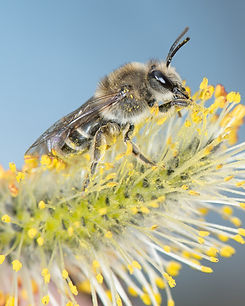
Family Colletidae > Genus Hylaeus
Hylaeus
Masked (Yellow-faced) Bees
In Minnesota, there are fourteen described species within the genus Hylaeus including one introduced non-native species, Hylaeus leptocephalus. Bees in this genus construct solitary nests in pithy plant stems and cavities in wood. Some species can produce more than one generation per year (bivoltine). Hylaeus are linear black bees with white or yellow markings on the face and legs. One species, Hylaeus nelumbonis, has red markings on its black abdomen. Another, Hylaeus basilis female, is almost entirely black, lacking any prominent white or yellow markings other than subtle markings on the abdomen. Males have prominent markings encompassing most of their face and females have two equal-sized patches. Hylaeus look like small mason wasps; they are almost hairless and females lack pollen-collecting hairs on their hind legs.
Females ingest then store pollen and nectar in their crop to transport the provisions internally back to their nest, where they are regurgitated into a prepared brood cell. Each nest cell is waterproofed with a combination of their saliva and secretions from their Dufour's gland (a gland in their abdomen). The mixture dries and produces a cellophane-like lining that holds the liquid provisions in the cell and provides a barrier for water and fungal/bacterial penetration. Hyaelus have a short bilobed or forked glossa (tongue) that they use to distribute the waterproofing liquid in their nest cells. Bees in this genus have two forewing submarginal cells, are very tiny, and range in length from 2 to 12 mm (0.07 to 0.47 inches).

A Hylaeus female visiting Rosa blanda.

wing
position
on flowers

N0. species in MN
14
size range

Phenology

Genus Characteristics

Dull black integument and yellow or white markings on the face, thorax, and legs.
female

Linear form, wasp-like nearly hairless body. Females lack pollen-collecting hairs on hind legs.
female

male
Male with yellow or white markings encompassing most of the face.

female
Females with two equal-sized white or yellow markings on the face.
Distribution

Hylaeus affinis

Hylaeus annulatus

Hylaeus basalis

Hylaeus fedorica

Hylaeus floridanus

Hylaeus illinoisensis

Hylaeus leptocephalus

Hylaeus mesillae

Hylaeus modestus

Hylaeus nelumbonis

Hylaeus rudbeckiae

Hylaeus saniculae

Hylaeus sparsus

Hylaeus verticalis
Hylaeus Species in Minnesota
Scientific Name | Likely Lecty | Host |
|---|---|---|
Hylaeus affinis | polylectic | |
Hylaeus annulatus | oliogolectic | Rosaceae (Scott 1996, Gibbs 2023) |
Hylaeus basalis | oligolectic | Rosaceae (Scott 1996, Gibbs 2023) |
Hylaeus fedorica | polylectic | |
Hylaeus floridanus | polylectic | |
Hylaeus illinoisensis | polylectic | |
Hylaeus leptocephalus | oligolectic | Facaceae (Gibb 2023) |
Hylaeus mesillae | polylectic | |
Hylaeus modestus | polylectic | |
Hylaeus nelumbonis | polylectic | |
Hylaeus rudbeckiae | polylectic | |
Hylaeus saniculae | polylectic | |
Hylaeus sparsus | oligolectic | spring-flowering Apiaceae (Arduser) |
Hylaeus verticalis | polylectic |
Source: Minnesota Department of Natural Resources, Minnesota Bee Species List (August 2023).
https://files.dnr.state.mn.us/eco/mcbs/mn-statewide-bee-list.pdf
Explore More Colletidae Genera
Explore Bee Families

Apidae
15 genera, 133 species
Bumble bees Bombus
Longhorn bees
Epimelissodes, Eucera, Melissodes
Carpenter bees
Ceratina, Xylocopa
Honey bees Apis
Digger bees Anthophora
Cuckoo bees Brachymelecta, Epeolus, Holcopasites, Nomada, Neolarra, Triepeolus
Squash bees Xenoglossa

2 genera, 39 species
Halictidae
10 genera, 133 species
Metallic green sweat bees
Agapostemon, Augochlora, Augochlorella, Augochloropsis
Large sweat bees
Dieunomia, Nomia
Short-faced bees Dufourea
Sweat bees Halictus
Small sweat bees Lasioglossum
Cuckoo (blood) bees Sphecodes
Megachilidae
14 genera, 86 species
Resin and pebble bees Anthidiellum, Dianthidium, Heriades, Paranthidium
Carder bees Anthidium, Pseudoanthidium
Mock orange bees Chelostoma
Mason bees Osmia, Hoplitis
Leafcutter bees Megachile
Sharp-tailed cuckoo bees Coelioxys
Dark cuckoo bees Stelis

Citations and Further Reading
Droege, S., et al. (2024). The Very Handy Bee Manual: 2.0. How to Catch and Identify Bees and Manage a Collection.
Gibbs, J., Hanuschuk, E., Miller, R., Dubois, M., Martini, M., Robinson, S., ... & Onuferko, T. M. (2023). A checklist of the bees (Hymenoptera: Apoidea) of Manitoba, Canada. The Canadian Entomologist, 155, e3.
Mitchell, T. B. (1960). Bees of the eastern United States. Technical Bulletin No. 141. North Carolina Agricultural Experiment Station.
Portman, Z. M., Gardner, J., Lane, I. G., Gerjets, N., Petersen, J. D., Ascher, J. S., ... & Cariveau, D. P. (2023). A checklist of the bees (Hymenoptera: Apoidea) of Minnesota. Zootaxa, 5304(1), 1-95.
Wilson, J. S., & Messinger Carril, O. J. (2016). The bees in your backyard: a guide to North America's bees. Princeton University Press.
Page Photography Credits
Heather Holm






